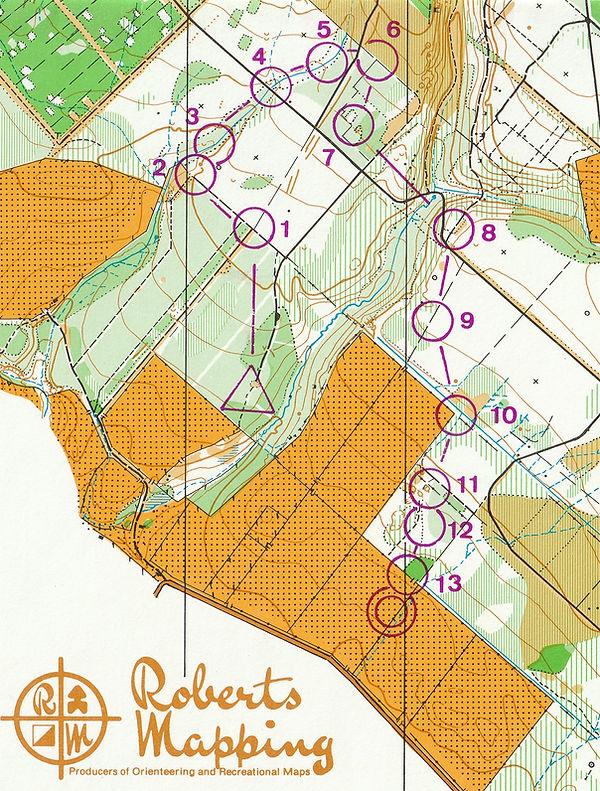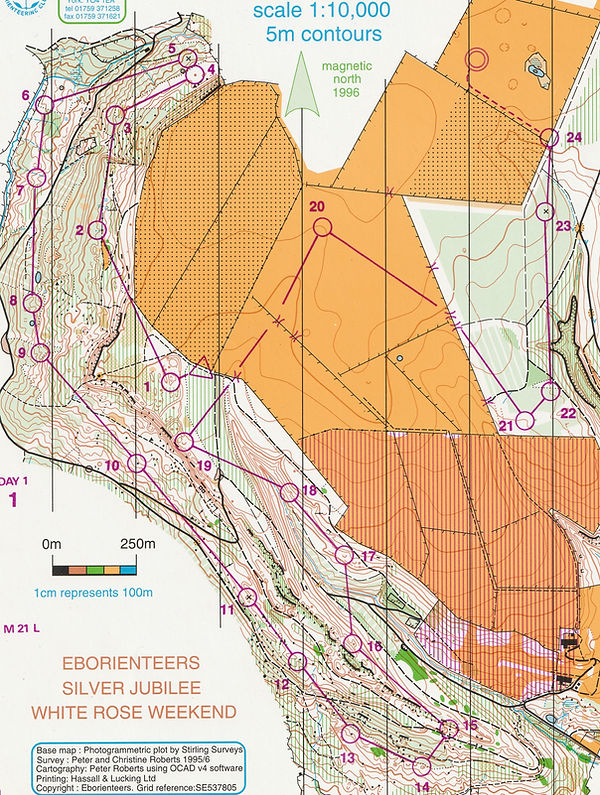
A Brief History of the White Rose from 2022
This family-friendly 4 days of competitive orienteering was the brainchild of the Roberts Family (Vic and Betty, with sons Peter and Steve). They had enjoyed the Welsh Weekend run by John Disley and the Mammoth master-minded by Lol Clarke so when the 3-years-old club Eborienteers were awarded the August Bank holiday weekend for a major fixture by the British Orienteering Federation, Vic proposed a 3-day event using one forest and one campsite with all the events within walking distance.
This was intended to be a one-off but the widespread acclaim it received meant that the club were allocated the date on a permanent basis. The format has stayed pretty much the same with the addition of a Friday evening event and a bonus mountain bike O on the Monday afternoon… and a trail O… and a big maze… and a sprint… ok we have sometimes got a bit carried away!
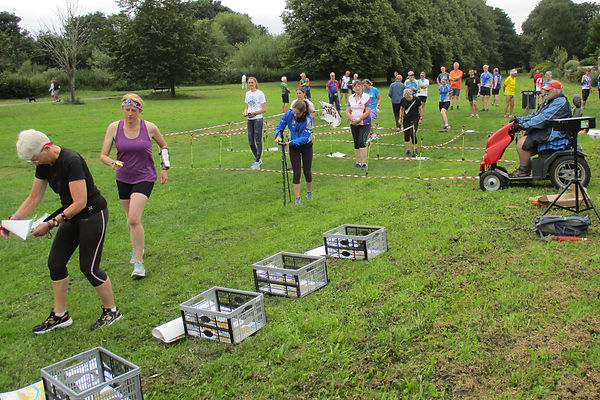
2021 day 2 start.
1972; the first White Rose.
“August 26th to 28th The White Rose Weekend (4 events in 3 days)” the advert said: a badge (classic) Saturday, a relay Sunday and both a line event and a score event on the Monday. At the time the average attendance at a badge event was about 200 so the club was a little shocked when 250 pre-entered (by snailmail enclosing a cheque of course) and a further 100 turned up to enter on the day. As has become the norm, the event had to rely on the help of non-orienteering friends and members of other clubs.
In those days there were a lot more young folk (126 on the on M21 and only 9 men over the age of 50), and a lot more men than women (only 24 in the Women’s Open and 2 over 50). And lots of juniors… the event has always prided itself on its family friendly philosophy.
Sue Harvey (of Harvey’s Maps fame) won the Women’s Open and Harold Harung (a Norwegian living in Britain) won the Men’s in a time of 84.44 for the course below including the time it took him to copy down the course!
Alan Ross was the organiser and remembers using a Gestetner duplicator in his caravan to provide the results of the Saturday event before breakfast the next day! With neither computers nor dibbers, in those days it took a large team of people several hours to check each competitor had visited all the controls and then produce a ranked list for each class.
The map had been used for a big international team event the previous year with 250 hours of survey work (aided by aerial photos arranged by the army) producing a “high quality 1:20,000 5-colour maps drawn by Bill Bushell to international standards”. I think I’ll try this course some time this year…

The 1976 event planned for Wykeham Forest was the first disaster. This was the driest year on record and there were fires on the North York Moors leading to the Forestry Commission withdrawing permission 4 days before the event. Showing a complete ignorance of our sport, they only banned orienteering and not the campsite or other tourist activities in the forests. There was no internet so the cancelation was announced on national TV and radio but many still turned up to camp and proceeded to organise their own events in nearby Raincliffe Woods (not Forestry Commission owned) using spare EBOR maps. No fires ensued. In those days blank maps were printed, enough for several events, and then the courses were added later. Printing set up costs were high so, once set up, it was worth doing a long run (usually at least 1,000 copies). Both paper and printing were expensive so the cost of each map was relatively much higher than it is today.
The club minutes record that “cash flow problems occurred due to the cancellation of the White Rose and the need to pay for the unused Wyekham maps. The committee agreed it needed to rebuild its reserve as there was only £354 in the various accounts”
Luckily, Robinsons started to sponsor the event (providing squash, paper cups, start and finish banners) and over 700 people attended in 1977 when the White Rose made a profit of £555 (and 1,800 blank Cropton maps left for future events).
In 1978 the White Rose was the club’s largest event ever with 1,200 competitors for the individual days and 900 for the relays. This was a massive undertaking for a club with about 150 members. All ages have to be roped in!

Rosie and Jenny Whitehead (the latter wearing a 1981 White Rose T shirt).
1982 minutes: “Vic Roberts has worked out a simple program which could be used in conjunction with a micro-computer to prepare results for the White Rose. The committee thought that perhaps TSB would allow us time on their computer. Club member David Nield is a technician with the bank.”
TSB printed the White Rose entry forms at no charge. The insurance against cancellation of the White Rose at a premium of 8% of the sum involved was considered too expensive.
For the White Rose Relays, planner Steve Whitehead wrote a program for the Sinclair Spectrum (a tiny computer) to produce a random allocation of the gaffled courses for each team member.
1984: Letters were sent out to lots of local firms asking for sponsorship of maps in return for an advert. Lots of negative replies but the White Rose map that year had some ads on the back (Guy Goodair Sports, The Sweat Shop and Ultrasport). The club received a £2,000 grant from the sports Council to help with White Rose mapping costs.
With entries growing, there was a discussion about making the event pre-entry only and a disc-drive and discs were purchased so that the time needed to produce results could be reduced. Eventually it was decided that entries would not be taken on the Friday evening as so many helpers were needed for other jobs. There were 1,328 entries by July 17th along with 183 relay teams and 372 campsite pitches had been booked. In the end there were 1,760 entries and by 1990 a peak of 1,860 finishers.
In 1993, the event returned to Broxa but with a rather different map (see below)
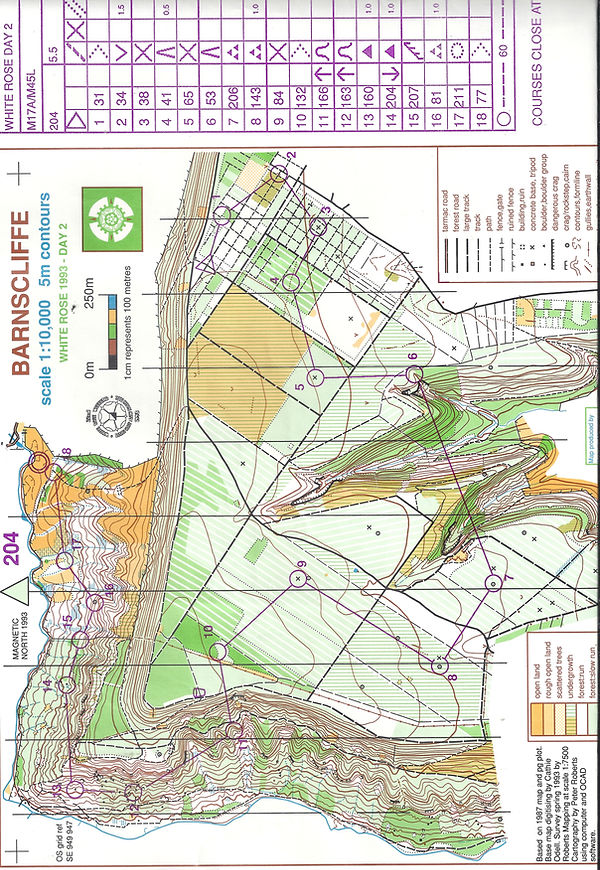
Planner Les Bresnen was pleased with leg 6 to 7. He reckoned it was best to double back and go all the way round to the north.
1994: Peter Roberts organised the White Rose. Nestlé provided kit-kats for all finishers on day 2 and smarties for those on the string course. There were 1,500 competitors each day and 250 teams in the relay.
1996: The White Rose 1996 was organised by Michel Johnson and planned by Steve and Jenny Whitehead (now Johnson). The second day became a chasing start to celebrate the silver jubilee of the event. There was commentary on the chase with Nick Lightfoot (SYO) commentating. There was also a marquee with a bar run by a local publican and a barn dance, and mementos and T-shirts. The event was budgeted to make a loss (the club having huge reserves) but members were still a bit spooked to find the reserves were only £4,000 by the end of the year. The weekend also included the British Trail O Championships.
Julie (club secretary) and Peter (a hard-working organiser) Udris did an enormous amount of work for the White Rose and even managed to produce on-site showers a few times!
In 1999 attendance dipped below a thousand… there were by now a huge number of summer multi-day events abroad and air travel had of course become relatively cheap. Foot and Mouth Disease caused another cancellation in 2001. Numbers declined further though the event retained its family-friendly ambience (always the focus of Gerry Goodridge’s philosophy during the many years when he chaired the club committee) and still attracted a loyal following.
2006: The White Rose was held in Wykeham. Nick Barrable, writing in CompassSport, couldn’t believe there were no brambles: “Could this really be the White Rose?” He also enjoyed Wilf’s (the legendary caterers of the time), the beautiful riverside campsite (“bargainsomely cheap”), and the little pub 20 minutes’ walk away. Nick particularly enjoyed being in the winning men’s team for the Monday morning Harris Relay that replaced the traditional relay format. This was basically a team event where, before running off, the team had to divide the controls up so that, between them, they could visit them all. The team’s time was the time of the last member to reach the finish. It meant the whole event ended earlier so people could set off home at a reasonable time and it was hoped it would reverse the trend of competitors leaving the White Rose on Sunday evening. The start was exciting with all the teams setting off on the same course at the same time. The results were split into 11 classes based on gender/age. A 2-hour bike event followed for those who wanted even more exercise!
2007: The club was having ongoing problems getting people to organise the White Rose and there were lots of discussions about the future of the event. Quite a few members thought it was too much of a strain on the club to put this on every year, some wanted to move it to May and others were adamant that it continue as an August 3- or 4-day event. The committee went so far as to ask other Yorkshire Clubs if they wanted to host the 2008 White Rose. AIRE and CLARO offered to do so but EBOR members revolted.
In the end, Bill Griffiths (formerly of SAXONS) rode to the rescue and offered to continue as co-ordinator, restoring its former prestige and increasing the attendance figures. One of the changes Bill made was to plan further ahead; in January each year, he would start organising the White Rose for the following year (having already sorted out the current year’s event). He streamlined the organisation, improved the advertising and commissioned new high-quality maps.
The 2007 White Rose in Pickering Forest, co-ordinated by Bill Griffith, was “one of the best in recent times” according to the EBOR minutes. Bill reported that the use of Fabian 4 for online pre-entry was much better than the old system (letters and cheques). Also, printed results were no longer needed now results were on the website. The introduction of a night event was also a great success, as was the barbecue and cricket match. The committee agreed that Bill did a great job and would write a formal letter of thanks. Bill went on to co-ordinate the next 7 White Roses, many with Steve Whitehead as planner of the main events and Steve Corrigan for the sprint and night events. Many helpers will remember Bill’s very detailed briefing papers for each job!
Bill and Steve (Whitehead) also introduced the (heretical to some) idea of an urban day with classic courses in the wonderful orienteering terrain of Scarborough.
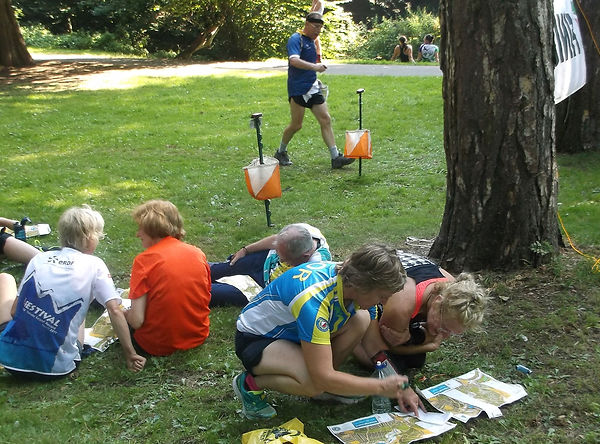
2019 finish in Scarborough.
Great thanks are due to the Roberts Family: Vic for the original idea and many years as organiser/surveyor/mapper, Betty who handled the entries for decades (all done by post), Peter for lots and lots of maps (as well as organising and planning several times including the first one) and Christine and Steve who must have covered many a mile of rough terrain surveying the North Yorkshire forests, many of them for the first time. One of the problems of the August White Rose is that it gives a (slightly) false impression of the toughness of Yorkshire’s undergrowth… it really is better running in spring, honest!
And so we come to the 50th anniversary and the 48th White Rose after another cancellation in 2020 and a small-scale version (but still with a super campsite) in 2021.
This year’s White Rose will be in Gilling and is now authorised by Forestry England. After lots of covid-related organisational problems we now have an excellent campsite, classic, middle, sprint, night, bike O, team race, maze and charity mega-quiz on offer over the 4 days… don’t worry, you don’t have to do them all!
Come along and bring your mugs/postcards/T shirts!
Steve Whitehead 2022.
Below: Team event prize-giving 2018 (note the hand-me-down 1984 T shirt) and the MBO crowd about to set off.
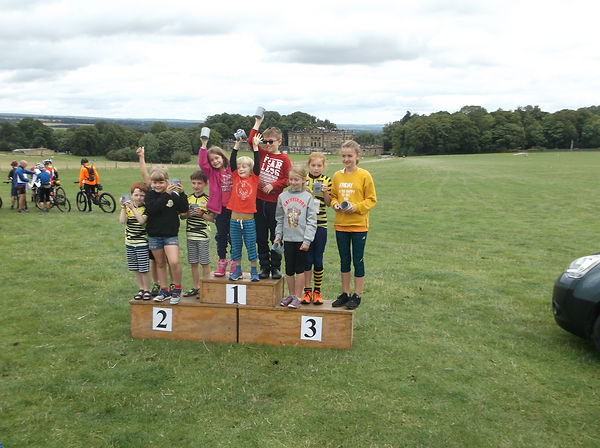

Some other maps from White Rose events
